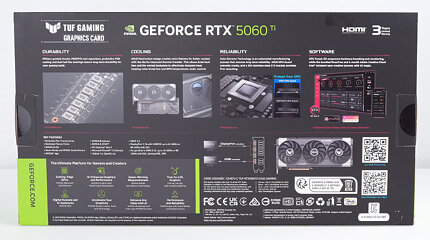 125
125
ASUS GeForce RTX 5060 Ti TUF OC 16 GB Review
Circuit Board Analysis »Packaging
The Card
Visually, the ASUS RTX 5060 Ti TUF OC follows the design theme of the company's previous TUF cards, and it also matches the RX 9070 TUF visuals exactly. On the back you get a high quality metal backplate with a cutout for air to flow through.
Dimensions of the card are 30.0 x 13.5 cm, and it weighs 1131 g.
Installation requires three slots in your system. We measured the card's width to be 62 mm.
Display connectivity includes three standard DisplayPort 2.1b and one HDMI 2.1b.
Standard for all GeForce RTX 50-series Blackwell cards is a new display engine that supports three DisplayPort 2.1b outputs, each capable of UHBR20; and one HDMI 2.1a. Both interfaces support DSC (display stream compression). With DSC enabled, a single DisplayPort on this card can drive 4K 12-bit HDR at 480 Hz; or 8K 12-bit HDR at up to 165 Hz. The RTX 5060 Ti features an updated media acceleration engine with support for 4:2:2 video formats, AV1 UHQ, and MV-HEVC. Unlike the bigger RTX 50 models, which have two, there is a single NVENC and NVDEC unit each.
The card uses a single 16-pin connector, which, theoretically, allows a maximum power draw of 600 W. The card's power limit is set to 180 W, with up to 234 W allowed with manual increases.
There's an RGB lighting zone on the backplate, near the TUF logo. The logo on the corner is not illuminated (unlike other TUF cards)
This BIOS switch lets you toggle between the default Performance BIOS and an optional "Quiet" BIOS.
Teardown
The fan assembly can be removed easily, which makes it easy to replace a broken fan in a couple of years—no need to touch the thermal paste of the card.
ASUS has installed five heatpipes on their thermal solution, the main heatsink also provides cooling for the memory chips and VRM circuitry.
The backplate protects the card against damage during installation and handling. Note the thermal pads, which provide cooling for the memory chips on the back side of the PCB.
Apr 25th, 2025 00:07 EDT
change timezone
Latest GPU Drivers
New Forum Posts
- Cracks in my cpu waterblock should I be concerned? (13)
- What's your latest tech purchase? (23595)
- Have you got pie today? (16677)
- Are the 8 GB cards worth it? (177)
- pc randomly blackscreening (0)
- What are you playing? (23462)
- I dont understand the phone OS world..... (49)
- New OLED monitor makes PC unresponsive sometimes (28)
- RTX 5070ti - Which MSRP model has the better/quieter cooler design, ASUS Prime, Gigabyte Windforce or PNY? (7)
- I tried to use AMD Auto Overclock, and now my PC has been freezing up sometimes. Afterwards, the screen goes black or displays artifacts. (29)
Popular Reviews
- NVIDIA GeForce RTX 5060 Ti 8 GB Review - So Many Compromises
- Crucial CUDIMM DDR5-6400 128 GB CL52 Review
- Colorful iGame B860M Ultra V20 Review
- ASUS GeForce RTX 5060 Ti TUF OC 16 GB Review
- Upcoming Hardware Launches 2025 (Updated Apr 2025)
- Sapphire Radeon RX 9070 XT Pulse Review
- Sapphire Radeon RX 9070 XT Nitro+ Review - Beating NVIDIA
- ASRock X870E Taichi Lite Review
- AMD Ryzen 7 9800X3D Review - The Best Gaming Processor
- ASUS GeForce RTX 5080 TUF OC Review
Controversial News Posts
- NVIDIA GeForce RTX 5060 Ti 16 GB SKU Likely Launching at $499, According to Supply Chain Leak (182)
- NVIDIA Sends MSRP Numbers to Partners: GeForce RTX 5060 Ti 8 GB at $379, RTX 5060 Ti 16 GB at $429 (127)
- NVIDIA Launches GeForce RTX 5060 Series, Beginning with RTX 5060 Ti This Week (115)
- Nintendo Confirms That Switch 2 Joy-Cons Will Not Utilize Hall Effect Stick Technology (105)
- Nintendo Switch 2 Launches June 5 at $449.99 with New Hardware and Games (99)
- Sony Increases the PS5 Pricing in EMEA and ANZ by Around 25 Percent (84)
- NVIDIA PhysX and Flow Made Fully Open-Source (77)
- Windows Notepad Gets Microsoft Copilot Integration (75)





















